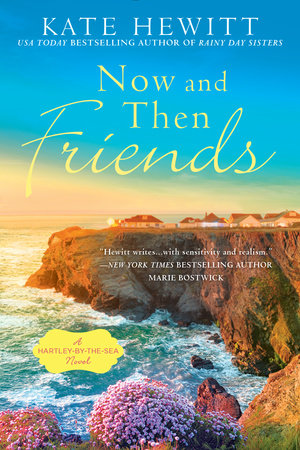READERS GUIDE
A Conversation with Kate Hewitt Q.
In what ways did the Cumbrian setting inform these characters as you were writing Now and Then Friends?
A. Having lived in an isolated village like Hartley-by-the-Sea, I know the impact of such a place on your psyche, both for good and bad. When I first moved to Cumbria, I struggled with some of the aspects of the region that the characters in the book also struggle with—the rainy weather, the lack of anonymity, the sense of remoteness. I learned to see the benefits of all these things, and I think my characters do as well—with time and effort!
Q.
As an American living in England, did you experience any “outsider” moments that helped you relate to how Claire might have felt returning to Hartley-by-the-Sea after so many years away? A. Yes, I have had many outsider moments, whether it is simply using the wrong word or not observing a traditional British custom (such as not eating birthday cake at a party—you wrap it in a napkin and put it all squashed in the party bag!). I’ve learned to laugh about it, and when I’m not sure what the protocol is, I say so up front. Just recently I had a funny conversation with friends about the differences between British and American English, and we all laughed a lot at the differences that seem minor but still matter.
Q.
The theme of sisterhood is so rich in this novel. Do you expect that Claire’s personality would have been different if she had had a sister to share things with growing up, as Rachel did with Meghan? A. Having a sister myself, I well know the joys and difficulties of that sibling relationship! I think Claire felt very isolated by her partial deafness and many illnesses during her childhood; in some ways Rachel acted like a big sister to her, helping and protecting her. Perhaps if she’d had someone at home to do that, she wouldn’t have become such good friends with Rachel.
Q.
Do you feel that early-childhood friendships can last well into adulthood? How do the changes we experience as we develop our adult selves impact these friendships? A. I think childhood friendships can last when the people involved keep in touch and grow together. This didn’t happen for Rachel and Claire until they reunited; even though they feel they were always friends, I think they had to develop a separate friendship as adults.
Q.
How was the experience of returning to some familiar faces from your previous Hartley-by-the-Sea book in this novel? Did you enjoy giving readers another glimpse into Lucy’s and Juliet’s lives in Now and Then Friends? A. Yes, I feel quite at home in Hartley-by-the-Sea, and the characters seem more real, their lives richer, with each story. It’s always nice to follow up with characters from previous books, and I hope to include Lucy and Juliet (and Claire and Rachel) in the next book.
Q.
Do you have any rituals in your writing day? A. Grabbing as much time as I can! As the mother of five young(ish) children, it can be hard to find time to write. I find it most efficient to write in short bursts and then take a five-minute break before starting again. A cup of tea does not go amiss, either.
Q.
As an author, what things most inspire you? A. I’m inspired by what I see around me, whether it’s a simple human interaction or a crisp sunny morning. I tend to get ideas while I’m walking my children to school or the dog in the local woods, and then let my subconscious untangle the knots. I think inspiration is everywhere if you are of a mind to look for it.
Questions for Discussion 1. What did you most enjoy about
Now and Then Friends? Who was your favorite character? To whom could you most relate?
2. Why do you think Claire and Rachel were drawn to each other as children? Does Rachel’s response to Claire upon meeting her again seem understandable to you?
3. Claire struggles with feeling adrift in life and allows other people to manage her life. Can you relate to her predicament at all?
4. Rachel’s relationship with her sister, Meghan, is fraught, due to the family struggles they had growing up. Have the issues your family had while you were growing up affected your adult relationships?
5. Why do you think Claire and Rachel stopped being friends in primary school? How did they both contribute to the end of their friendship?
6.
Now and Then Friends has a colorful cast of secondary characters, including Andrew West, Dan Trenton, Abby Rhodes, Emily Hart, Rob Telford, and Eleanor Carwell. Which of these characters did you enjoy reading about the most? Who would you like to read about in his or her own story?
7. Is Rachel justified in her actions toward Lily regarding her choices of subjects?
8. What do you most like about Hartley-by-the-Sea? What would you find the most challenging about living there?
9. Do you think Rachel made the right choice in leaving university to come home? Do you understand her reasoning about not wanting to “settle”?
10. How does Claire help other people in the village, such as Dan Trenton and Eleanor Carwell?
11. How do you think Rachel and Claire both grow and change through the story? How do they help each other to do this?
12. Which part of
Now and Then Friends resonated the most with you? What will you remember about the book long after you’ve read it?

